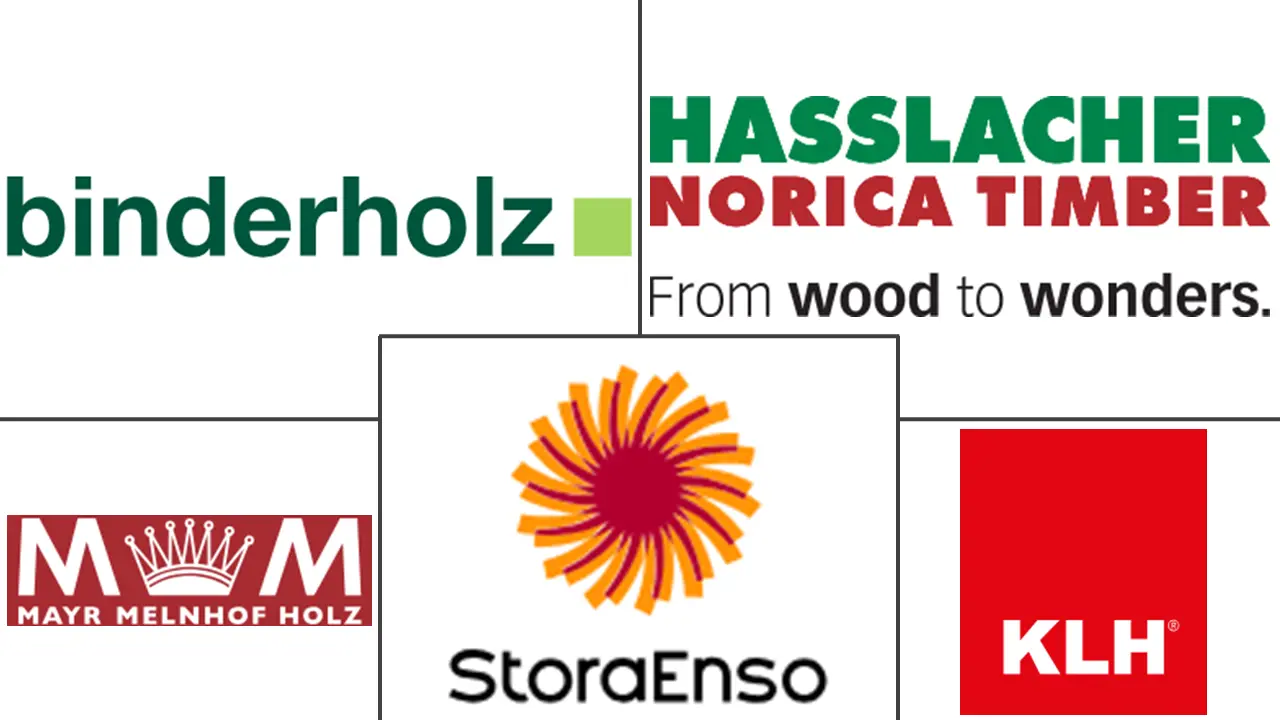Cross Laminated Timber Market Size and Share
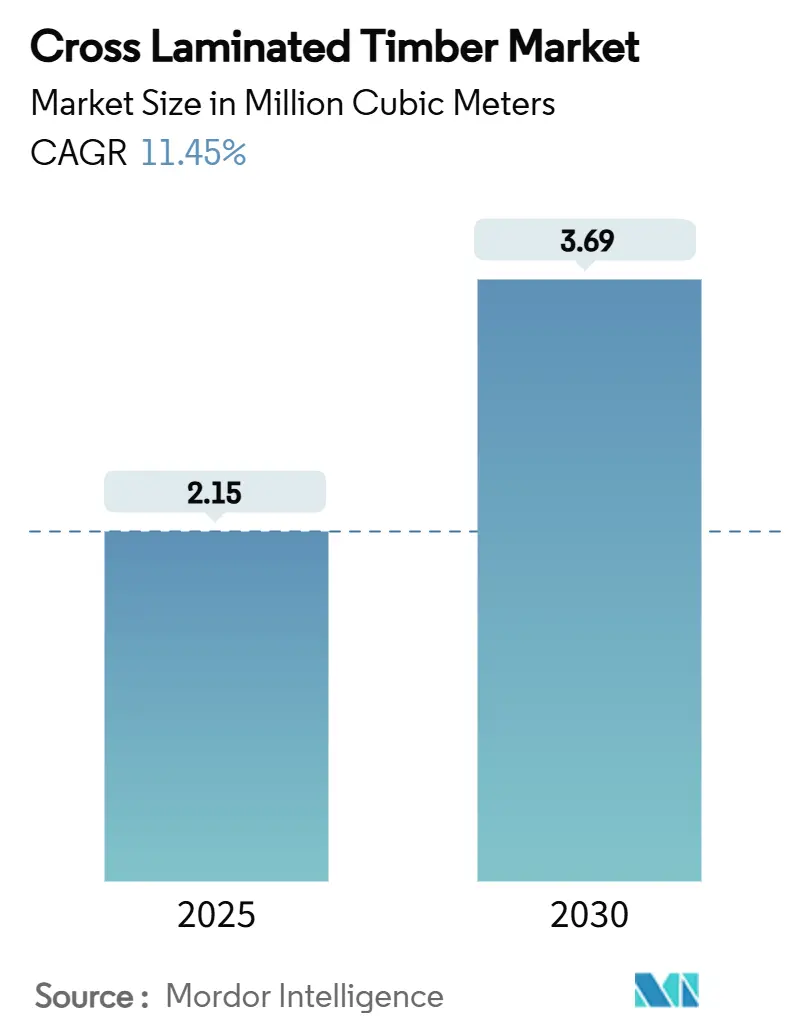
Cross Laminated Timber Market Analysis by Mordor Intelligence
The Cross laminated timber Market size is estimated at 2.15 Million cubic meters in 2025, and is expected to reach 3.69 Million cubic meters by 2030, at a CAGR of 11.45% during the forecast period (2025-2030). Rapid demand escalation signals the material’s shift from a niche green option to a mainstream structural solution, helped by tightening carbon‐pricing rules, advances in modular construction, and mounting evidence of superior structural performance. Europe remains the chief demand center, benefiting from the EU Emissions Trading System’s (EU ETS) looming extension to building construction and carbon prices expected to exceed EUR 222/t by 2030. North America follows with code revisions that now allow taller mass timber structures, while the Asia-Pacific region is moving from pilot projects to early commercial adoption as certification bottlenecks ease. Competitive intensity is rising, yet capacity additions—such as Mayr-Melnhof Holz’s new 140,000 m³ line—indicate confidence in long-term cross laminated timber market growth.
Key Report Takeaways
- By bonding technology, adhesive-bonded solutions accounted for 90.88% of the cross-laminated timber market size in 2024, and are poised to grow at 12.12% CAGR through 2030.
- By raw-material species, spruce‐based CLT captured 48% of 2024 volume, while Douglas-Fir is expected to register the fastest growth at 12.56% CAGR through 2030.
- By element, wall panels led with 54.71% revenue share in 2024, while roof panels are projected to expand at a 13.02% CAGR to 2030.
- By application, the non-residential segment held 50.08% of cross-laminated timber market share in 2024; residential is the fastest-growing application at an 12.34% CAGR through 2030.
- By geography, Europe dominated with 53.61% cross laminated timber market share in 2024; Asia-Pacific is projected to post the highest regional CAGR of 17.33% to 2030.
Global Cross Laminated Timber Market Trends and Insights
Drivers Impact Analysis
| Driver | (~) % Impact on CAGR Forecast | Geographic Relevance | Impact Timeline |
|---|---|---|---|
| Growing Modular Construction With Government Financial Support in EU & Canada | +2.30% | Europe, Canada | Medium term (2-4 years) |
| Shifting Consumer Preferences Towards Sustainable Building Material | +1.80% | Global | Long term (≥ 4 years) |
| Superior Structural Performance | +1.50% | Global | Long term (≥ 4 years) |
| Rising Demand for Mid-Rise and High-Rise Timber Buildings | +1.20% | Europe, North America | Medium term (2-4 years) |
| Carbon-Pricing Escalation in Europe Favouring Low-Embodied-Carbon CLT | +2.00% | Europe | Short term (≤ 2 years) |
| Source: Mordor Intelligence | |||
Growing Modular Construction With Government Financial Support in EU & Canada
Government grants, preferential procurement, and updated handbooks are catalyzing a modular construction boom anchored in CL T. The Australian Building Codes Board’s 2025 handbook provides prescriptive pathways for prefabricated timber compliance and removes a long-standing regulatory hurdle[1]. In Canada, federal innovation funds are channeling capital toward advanced housing technologies that rely on mass timber, citing 50–70% lower labor requirements and 30% faster project timelines relative to conventional builds. Similar incentives are emerging in Germany, Sweden, and France as municipalities seek rapid, low-carbon solutions to housing shortages. Public-sector pilots have moved from small pavilions to full-scale school and hospital blocks, validating Cross laminated timber industry’s cost and schedule advantages. The momentum is further evidenced by private equity inflows into modular timber factories across Scandinavia, the Baltic states, and British Columbia.
Shifting Consumer Preferences Towards Sustainable Building Material
Life-cycle assessments now quantify CLT’s embodied-carbon benefits, helping developers monetize environmental savings under emerging carbon-credit schemes. Substitution studies show that replacing high-carbon materials with CLT panels saves 0.81 t C per tonne of carbon in the product. Iconic projects such as 25 King in Brisbane demonstrated a 74% cut in embodied carbon and 46% lower operational energy, turning sustainability into a marketing asset for tenants and owners alike. The value narrative is strengthening as the EU ETS expansion will cover 75% of construction emissions by 2027, effectively taxing carbon-heavy materials and reinforcing CLT’s economic edge[2]European University Institute, “Carbon Pricing in Construction,” eui.eu . Corporate ESG mandates are boosting demand from tech, retail, and logistics operators eager to hit Scope 3 targets. Consumer awareness campaigns led by national forest agencies are broadening mainstream acceptance beyond early adopters.
Superior Structural Performance
Rapid research cycles have improved engineers’ confidence in CLT’s mechanical properties. Out-of-plane shear tests reveal that three-layer panels deliver 24% higher shear capacity than five-layer counterparts, allowing slimmer assemblies and taller spans. Hybrid systems such as Toronto’s Limberlost Place combine CLT slabs with concrete topping to balance mass, vibration, and fire resistance while cutting 5,426 t CO₂e compared with a steel frame. Seismic validation has advanced through shake-table trials where friction-pendulum bearings enabled ductility levels comparable to reinforced concrete, thereby unlocking markets in Japan, New Zealand, and the U.S. West Coast. The result is a migration of CLT from low-rise education and retail builds to hospitals, data centers, and even industrial mezzanines. New design codes published in 2025 by CSA O86 and EN 1995-1 reference these findings, streamlining permit approvals.
Rising Demand for Mid-Rise and High-Rise Timber Buildings
Building-code revisions now permit 18-story mass-timber towers in the United States under the 2024 International Building Code. Seattle’s Heartwood apartments adopt a hybrid post-and-beam system with 5-ply CLT floors, achieving a 38% lower Global Warming Potential versus concrete. Russia’s Segezha Group has entered the race with a 50,000 m³ line to supply domestic high-rise projects, underscoring the technology’s globalization. Financial institutions are more willing to underwrite timber towers as third-party fire-safety and durability data grows. Insurance premiums, historically a hurdle, have narrowed as large brokers create mass-timber underwriting pools. These shifts are stimulating a pipeline of over 6 million m² of mid-rise-plus mass-timber floor area now in design or early construction across Europe and North America.
Restraints Impact Analysis
| Restraint | (~) % Impact on CAGR Forecast | Geographic Relevance | Impact Timeline |
|---|---|---|---|
| Limited Hardwood-Grade Adhesive Certification Slowing Adoption in Asia | -1.10% | Asia-Pacific | Short term (≤ 2 years) |
| Volatile Spruce & Fir Prices Post Russia-Ukraine Conflict Raising EU CLT Costs | -1.40% | Europe | Short term (≤ 2 years) |
| Moisture Absorption-related Risks Of The Material | -0.90% | Humid & coastal regions | Long term (≥ 4 years) |
| Source: Mordor Intelligence | |||
Limited Hardwood-Grade Adhesive Certification Slowing Adoption in Asia
The absence of certified adhesives for hardwood CLT limits penetration in markets where spruce or pine supply is scarce. Experimental zero-thickness bio-adhesives improved lap-joint strength by 85%, yet formal approvals from JAS, EN, and ANSI bodies remain pending. The gap forces Asian producers to import costly softwood, eroding price competitiveness. Public–private research consortia, such as LIFE EcoTimberCell, are accelerating test programs, but commercial certification is unlikely before 2027. Developers, therefore, hesitate to commit to large-scale hardwood CLT projects, dampening near-term demand growth in China, India, and Southeast Asia. The issue spills over to supply chains, as adhesive manufacturers delay capital allocation for hardwood-specific production until standards converge.
Volatile Spruce & Fir Prices Post Russia-Ukraine Conflict Raising EU CLT Costs
Geopolitical disruptions have restricted log exports and raised Nordic fiber prices. Higher raw-material costs already triggered closures of two Scandinavian pulp lines in 2025, signaling broader structural strain on wood supply. Leading CLT players are responding through geographic diversification—Stora Enso’s recent forest asset purchase in Uruguay secures non-European feedstock, while Mayr-Melnhof Holz invests in integrated sawmills with 1.45 million m³ log-cutting capacity to insulate its panel lines[3]. Despite mitigation efforts, price volatility is squeezing smaller manufacturers that lack vertical integration, slowing project start‐ups and extending bid-lock validity periods across the EU cross laminated timber industry in the construction sector.
Segment Analysis
By Bonding Technology: Adhesive Solutions Dominate Manufacturing
Adhesive bonding accounted for 90.88% of the cross-laminated timber market in 2024, a position cemented by established European Technical Assessment (ETA) pathways and the ability to deliver large bilayer panels with minimal warping. Bio-based polyurethane and lignin-fortified epoxies are gaining commercial traction, addressing end-of-life recyclability concerns while matching shear strength benchmarks.
Mechanically fastened CLT remains a small but innovative niche. Nailed cross-laminated timber (NCLT) replaces adhesives with densified hardwood dowels, reducing chemical inputs and simplifying deconstruction. Although NCLT panels currently attract a 7–10% cost premium, their circular-economy credentials resonate with EU taxonomy investors. In parallel, research groups in Germany have advanced rotational wood-welding, producing bondlines in 2 seconds without glues while maintaining 80% of adhesive-bonded bending strength. Adoption hinges on automated manufacturing cells capable of high spindle speeds, technologies expected to reach pilot scale by 2026.
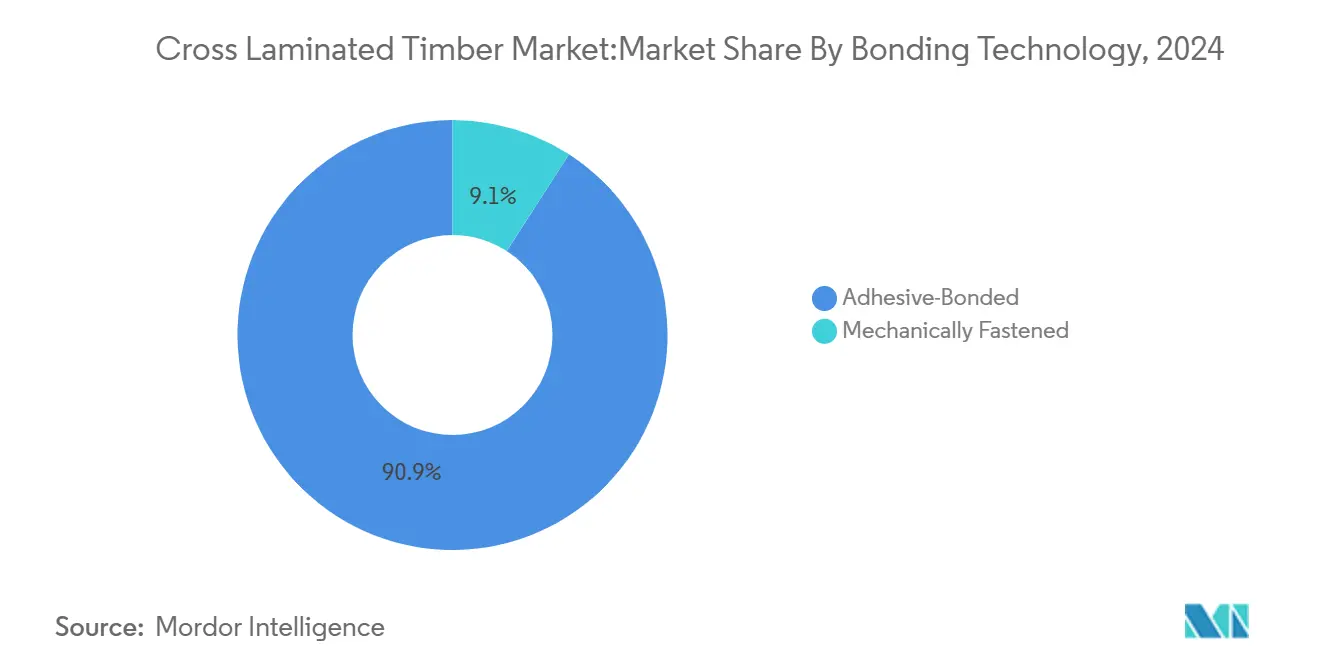
Note: Segment shares of all individual segments available upon report purchase
By Raw-Material Species: Spruce Dominance Challenged by Resource Constraints
Spruce constituted around 48% of 2024 global CLT volume, driven by Central European and Nordic forestry supply chains. Black spruce from Québec yields high stiffness-to-weight ratios, enabling 6 m clear spans in school gymnasiums built since 2024. However, climate change is pushing spruce viability zones northward, and bark beetle infestations have already decimated 30% of Bavarian stock since 2023, compelling producers to diversify.
Poplar and other fast-growing hardwoods are emerging as credible alternatives. Hungarian trials showed poplar CLT panels meeting EN 16351 load-bearing thresholds at 85% of spruce density. The cross laminated timber market will see poplar’s share rise as short rotation coppice plantations scale in southern Europe and China. Research is also reviving interest in beech and ash for specialty panels where high‐density layers improve vibration control in auditorium floors. These shifts will require new grading rules and bonding protocols, tasks already underway within the revised Eurocode 5 draft circulated in 2025.
By Element Type: Wall Panels Lead Structural Applications
Wall panels captured 54.71% of cross laminated timber market revenue in 2024 due to their versatility in prefabricated envelopes and load-bearing shear walls. Standardization around 3.2 m x 12 m formats allows efficient truck loading and rapid on-site craning, reducing installation crews to four workers per level on mid-rise projects. Floor panels trail but are gaining momentum. Composite CLT–concrete decks, such as those in Limberlost Place, deliver vibration performance comparable to steel solutions yet weigh 25% less. Roof Panel is projected to record a CAGR of 13.02% through 2030. Innovative combinations with steel diaphragms now extend timber footbridge spans to 24 m while retaining aesthetic warmth.
By Application: Non-Residential Sector Drives Innovation
Non-residential buildings held 50.08% revenue in 2024, led by office blocks that leverage CLT’s grid flexibility and exposed finishes for rental-rate premiums. Australia’s 25 King recorded a 74% carbon-reduction metric that helped secure anchor tenants under green lease terms. Cross laminated timber market share gains in this segment are propelled by universities and laboratories seeking fast-tracked capital projects with predictable cost envelopes.
Residential demand is expanding on the back of modular apartment products now hitting the U.S. and German markets. Factory-finished CLT cassettes allow a four-story, 60-unit complex to top out in under three weeks, saving 25% site labor hours relative to light-frame timber. Institutional/industrial uses, although smaller, benefit from policy grants such as the USD 115 million Darrington Wood Innovation Center, which integrates a CLT plant and demonstration hall to showcase advanced robotics in timber manufacture.
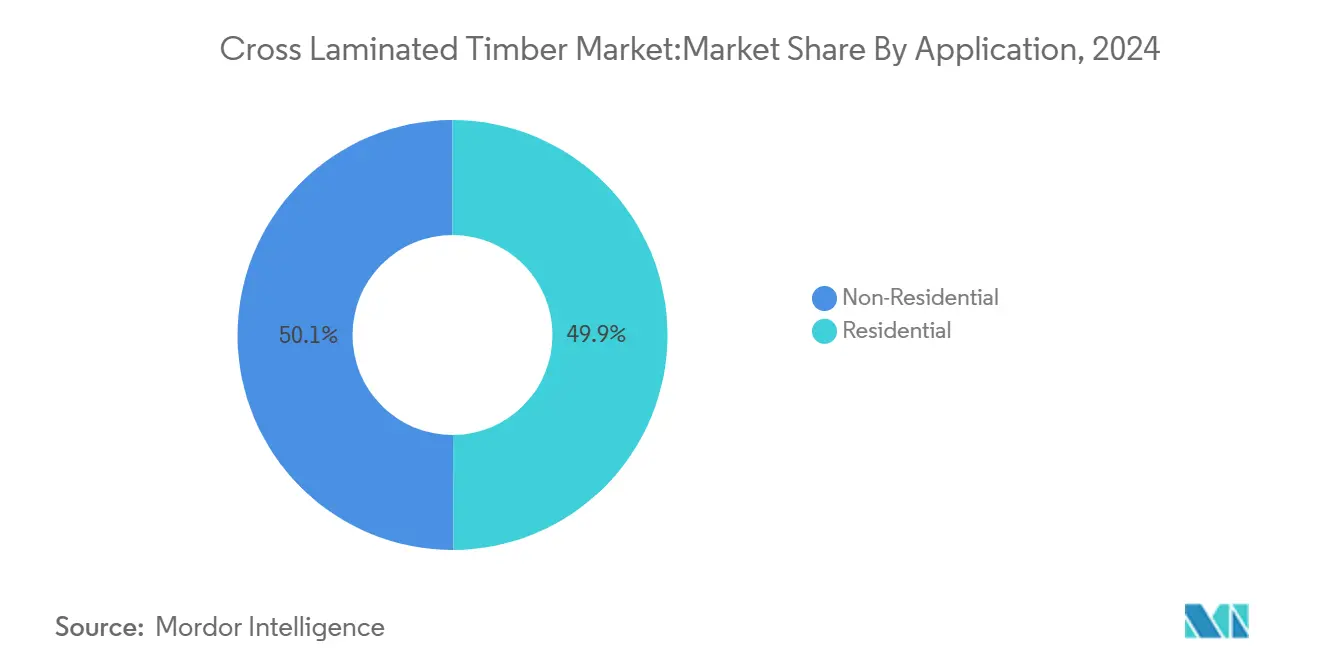
Note: Segment shares of all individual segments available upon report purchase
Geography Analysis
Europe commanded 53.61% of 2024 volume thanks to mature forest supply chains, supportive building regulations, and a single-market for CE-marked panels. Germany, Austria, and Sweden together consumed 790 thousand m³, with municipal housing initiatives driving half that volume. The EU ETS will further favor timber: by 2027, 75% of construction emissions fall under carbon pricing, adding a cost premium to concrete and steel that could widen to EUR 160/t CO₂e by 2030. Challenges persist, notably high stumpage fees and sanctions-driven shortages of Russian spruce, pushing average kiln-dried plank prices to EUR 410/m³ in early 2025.
North America is a significant market in the cross-laminated timber market as U.S. states adopt tall-timber provisions and Canadian provinces streamline mass-timber permitting. Southern yellow pine sawmill investments added 6 million m³ of annual capacity between 2023 and 2025, stabilizing raw-material costs. Flagship projects such as Microsoft’s Silicon Valley campus extension use CLT to realize 30% schedule compression, demonstrating commercial acceptance among major corporates.
Asia-Pacific is the fastest-growing market with a projected CAGR of 17.33% through 2030. Australia and New Zealand spearhead adoption through projects like the NIOA Brisbane Office Expansion, which trimmed installation time by eight days on a five-story annex. China is rolling out national design guidelines for prefabricated timber, and India has approved its first CLT-based affordable housing pilot in Gujarat. Adhesive-certification gaps for hardwood remain the sector’s biggest impediment, yet regional research collaborations with European laboratories aim to publish harmonized standards by 2027.
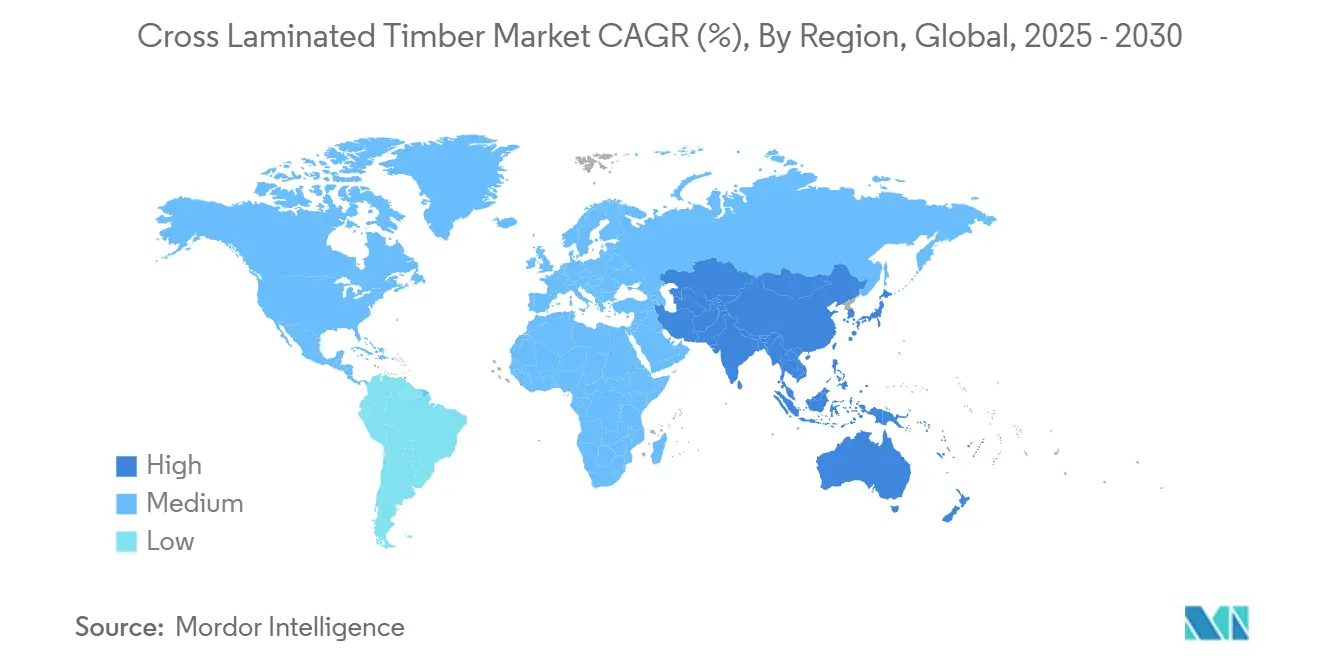
Competitive Landscape
The cross laminated timber market remains moderately fragmented: the top ten producers account for roughly 55% of global capacity. Stora Enso, Binderholz, Mayr-Melnhof Holz, KLH, and Nordic Structures lead European shipments, while Structurlam, SmartLam, and Katerra’s successor operations anchor the North American roster. Vertical integration is an overarching strategy: Stora Enso’s Uruguay forest purchase secures 56,000 ha of planting rights to de-risk future log supply. Binderholz’s 2025 upgrade of its Hallein mill integrates bioenergy boilers that feed panel presses, cutting utility costs by 19%.
Capacity expansion also remains brisk. Mayr-Melnhof Holz’s Leoben site delivers 140,000 m³ of CLT annually on an automated line featuring near-zero offcut waste, raising its global share to 6%. In Asia, Segezha Group’s Sokol mill’s 50,000 m³ line gives Russia its first industrial-scale CLT capacity, positioning the company for exports to China and the Gulf states. Emerging players focus on digitalization: hsbcad’s BIM-to-machine code software reduces shop-drawing time by 60%, attracting Maguar Capital’s majority stake to fuel global rollout.
Strategic white space lies in proprietary connectors, reversible bonds, and AI-assisted optimization of panel layouts that minimize waste. University-led prototypes, such as the Hybrid Flax Pavilion, underscore potential for multi-material laminates that combine CLT with bio-composites to attain lighter panels without sacrificing stiffness. Collaborations between software vendors and robotics integrators are accelerating “design-for-manufacture” flows, shortening project cycles and cementing a first-mover advantage for firms with advanced digital toolkits.
Cross Laminated Timber Industry Leaders
-
Binderholz GmbH
-
HASSLACHER Holding GmbH
-
KLH Massivholz GmbH
-
Mayr-Melnhof Holz Holding AG
-
Stora Enso
- *Disclaimer: Major Players sorted in no particular order
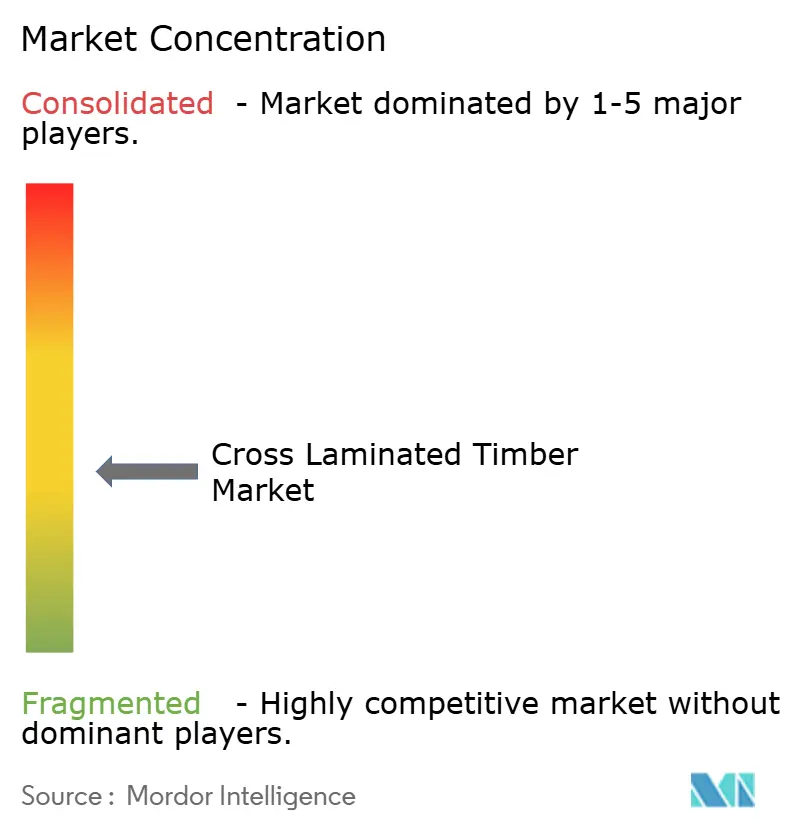
Recent Industry Developments
- March 2025: Binderholz GmbH introduced a decorative micro CLT, crafted from spruce and featuring a tongue-and-groove joint, designed for interior fittings and mass timber construction. This innovation is expected to enhance the adoption of cross-laminated timber in modern construction, driving growth in the cross-laminated timber market.
- February 2025: February 2025: Stora Enso announced the launch of over 2,000 new projects this year utilizing its Sylva CLT kit-of-parts, highlighting the increasing adoption of mass timber. This development is expected to significantly drive growth and innovation in the cross laminated timber market reinforcing its role as a sustainable construction material.
Research Methodology Framework and Report Scope
Market Definitions and Key Coverage
Our study defines the cross-laminated timber (CLT) market as factory-made structural panels built from three or more layers of sawn lumber arranged at right angles and bonded into large, dimension-stable slabs used in load-bearing walls, floors, and roofs. Units are expressed in cubic meters of finished CLT delivered from mills to construction projects.
Scope Exclusion: laminated veneer lumber, glue-laminated beams, and other engineered wood products are not counted.
Segmentation Overview
- By Bonding Technology
- Adhesive-Bonded
- Mechanically Fastened
- By Raw-Material Species
- Spruce
- Pine
- Fir
- Douglas-Fir
- Hardwood (e.g., Tulipwood, Oak)
- By Element Type
- Wall Panels
- Floor Panels
- Roof Panels
- Others (Elevator/Stair Cores and Bridge Decks and Other Infrastructure)
- By Application
- Residential
- Non-Residential
- Commercial
- Industrial/Institutional
- Other Applications (Military Housing, Emergency Shelters, Event Structure
- By Geography
- Asia
- China
- Japan
- India
- South Korea
- Thailand
- Vietnam
- Malaysia
- Indonesia
- Australia
- New Zealand
- Rest of Asia-Pacific
- North America
- United States
- Canada
- Mexico
- Europe
- Germany
- United Kingdom
- France
- Italy
- Spain
- Russia
- NORDIC Countries
- Turkey
- Rest of Europe
- South America
- Brazil
- Argentina
- Colombia
- Rest of South America
- Middle East and Africa
- Saudi Arabia
- United Arab Emirates
- Qatar
- Rest of Middle East
- South Africa
- Nigeria
- Egypt
- Rest of Middle East and Africa
- Asia
Detailed Research Methodology and Data Validation
Primary Research
We interview mill operators, timber-frame contractors, structural engineers, and code officials across Europe, North America, and fast-growing Asian hubs. Discussions verify typical line utilization, reject rates, price realization, and the pace at which mid-rise and modular builders substitute CLT for concrete. Short online surveys with architects give us adoption-probability curves that desk data cannot reveal.
Desk Research
Mordor analysts start with reputable public records, annual production reports from FAO-Forestry and UNECE Timber Committee, Eurostat trade files, U.S. Forest Service mill surveys, and building-permit dashboards from Statistics Canada and the Australian Bureau of Statistics. Company filings, investor decks, and environmental-product declarations then clarify mill capacities and panel size mixes. Paid resources such as D&B Hoovers (mill revenues) and Volza (export shipment counts) let us benchmark output against cross-border flows. These sources illustrate market depth, yet do not alone answer every sizing question; many additional references inform background checks and data cleaning.
Market-Sizing & Forecasting
A combined top-down and bottom-up model is built. National sawn-wood production, CLT mill nameplate capacity, average capacity utilization, and export-import balances reconstruct 2025 demand pools; supplier roll-ups and sampled ex-factory prices validate volumes and value. Key variables include: 1. Mill capacity additions announced through 2027, 2. Regional carbon-price trajectories, 3. Building permits for multi-story timber structures, 4. Average panel thickness trends, 5. Exchange-rate outlook affecting price parity. Multivariate regression projects each driver through 2030, while scenario analysis tests high-carbon-price and low-housing-start cases. Where supplier disclosures are partial, we interpolate using historical utilization bands cross-checked against shipment data.
Data Validation & Update Cycle
Outputs face three layers of review: variance checks against independent trade and permitting metrics, peer review by a senior analyst, and a final refresh before publication. The dataset is updated yearly, with interim revisions triggered by new mill start-ups, code changes, or material events flagged during continuous news monitoring.
Why Mordor's Cross Laminated Timber Baseline Earns Investor Trust
Published estimates often diverge because firms mix engineered wood types, use different price decks, or freeze models for years.
Key gap drivers include: some studies convert square-foot project data directly to revenue without verifying panel thickness; others model only Europe and stretch that ratio globally; a few adopt optimistic carbon-credit price paths that inflate value. Mordor Intelligence fixes scope to finished CLT panels, refreshes all variables annually, and aligns carbon-pricing assumptions with enacted policy, yielding a balanced baseline users can retrace.
Benchmark comparison
| Market Size | Anonymized source | Primary gap driver |
|---|---|---|
| 2.15 Mn m³ (2025) | Mordor Intelligence | |
| USD 1.81 Bn (2025) | Global Consultancy A | revenue only; excludes Asia-Pacific volume |
| USD 1.33 Bn (2023) | Research Publisher B | older base year; applies single global ASP |
| USD 1.17 Bn (2024) | Industry Journal C | omits mechanically-fastened panels |
In sum, Mordor's disciplined scope selection, live driver tracking, and cross-check routine deliver a dependable reference point for planners who need transparent, reproducible numbers.
Key Questions Answered in the Report
What is the current size of the cross laminated timber market?
The market stands at 2.15 million cubic meters in 2025 and is projected to reach 3.69 million cubic meters by 2030.
Which region leads the cross laminated timber market?
Europe holds 53.61% of 2024 volume, supported by stringent carbon-pricing rules and established supply chains.
What application segment is expanding the fastest?
Residential applications show the highest growth, advancing at an 12.34% CAGR through 2030 due to modular apartment demand.
How does CLT compare to concrete in carbon footprint?
Case studies such as Brisbane’s 25 King report a 74% reduction in embodied carbon versus conventional concrete structures.
What is the main restraint on CLT adoption in Asia?
Limited adhesive certification for hardwood species delays large-scale production where softwood supply is insufficient.
Which bonding technology dominates the cross-laminated timber market?
Adhesive-bonded CLT commands 90.88% of 2024 volume thanks to proven performance and mature certification pathways.
Page last updated on:
